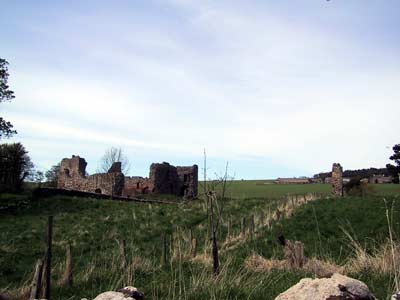 |
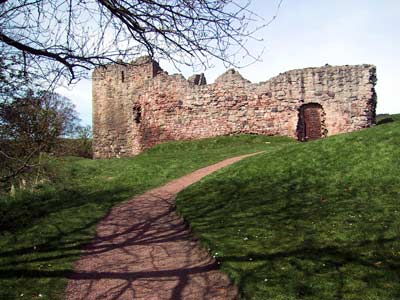 |
| In
a lovely location above a river, Hailes Castle consists of a 14th century
keep, extended by ranges and towers in the 15th and 16th centuries, within
a thick 13th century curtain wall. The castle had a large courtyard,
fragments of which remain. Hailes is one of the oldest stone castles surviving in Scotland. It was probably built by Hugo de Gourlay shortly before 1300. The Gourlays were an important Northumbrian family and Hugo's castle had more the appearance of an English manor-house than a Scottish baronial castle. Hailes, like all medieval castles, was the fortified residence of a nobleman and his family - firstly the Gourlays, then the Hepburns. It served chiefly as their private house, but it was also the centre of the lord's estate. Here the tenants came to pay their rents; here the lord dispensed justice (hence the two pit prisons); and here in troubled times the lord and his family, household and tenants took refuge. Hailes did not figure in a major siege, but it was attacked from time to time. In 1446 the pro-English Archibald Dunbar stormed the castle and "slew all that he found therein". The castle was burnt in 1532, and in 1547 was occupied by Lord Gray of Wilton for the English, and Cromwell's Roundheads are said to have dismantled the castle in 1650. The Gourlays lost their lands for supporting the English during the Wars of Independence in the early 14th century. Sir Adam de Hepburn became the new lord. The castle and lordship of Hailes remained with the Hepburns until 1567 when James Hepburn, 4th Earl of Bothwell and Mary, Queen of Scots' third husband, forfeited the lands. The Hepburns converted the manor-house into a strong castle. With the forfeiture of Bothwell, the castle passed first to the Stewarts and then to the Setons. But these noble families had their country seats elsewhere and the local tenantry probably took over the old halls and chambers, both for dwellings and for storage. In 1835 Hailes was being used as a granary, but in 1926 was transferred into State care. |
|
| Click here to see a reconstruction of the castle. | |
| James Hamilton, 2nd Earl of Arran, was governor of Scotland during part of the minority of Mary, Queen of Scots. He faced opposition from pro-English nobles such as Patrick Hepburn, 3rd Earl of Bothwell. In 1547 Bothwell was forced to surrender Hailes Castle to the Scottish government. However, in February 1548 the English captured and garrisoned the castle. Arran acted swiftly and retook Hailes. To prevent its future use by the English, the Scots removed the castle's iron gates. When James Hepburn became 4th Earl of Bothwell on his father's death in 1556, he succeeded to other titles and a good-sized estate. He was also Lord of Hailes, Crichton and Liddesdale, Lord High Admiral of Scotland, Sheriff of Berwickshire, East and Midlothian, and Baillie of Lauderdale, while inheriting extensive estates in eight shires. From 1565 Bothwell was keeper of Dunbar Castle, which further strengthened his position in East Lothian. | |
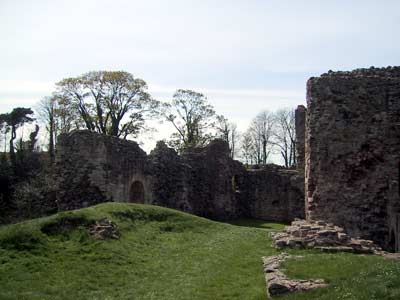 |
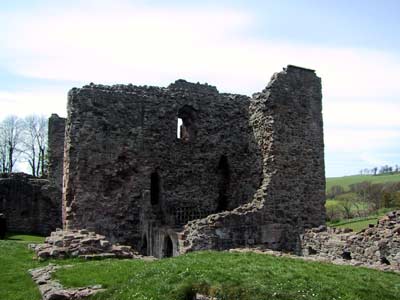 |
| When Mary's 40 days of mourning ended in March 1567, she allowed
her father-in-law, Lennox, to take out a private process before Parliament
against Bothwell as the killer of his son, Lord Darnley. However, Bothwell's
sympathisers were numbered in the thousands, while Lennox was permitted no more
than six supporters. He therefore stayed away from Edinburgh, while Bothwell was
acquitted for want of accusations. On 19th April, Bothwell took his cronies to
Ainslie Tavern in the High Street, for a lavish meal at his expense. Having
ensured that they were all suitably plied with drink, he then produced a
document wherein he re-affirmed his innocence in the Darnley murder, and put
himself forward as the only suitable husband for the widowed Mary. Argyll,
Cassilis, Glencairn, Huntly, Morton, Maitland, Sutherland, Rothes, Seton,
Sinclair, Boyd and Herries were among the 24 who were persuaded to append their
signatures to what came to be known as the "Ainslie Bond". It was
while Mary was at Seton that Bothwell, with the backing of Maitland, first
broached the subject of her re-marriage to him. Mary, who was well aware of the
recent scandals surrounding Bothwell, refused point blank and set off on an
unofficial visit to Stirling to see her son. On her way back to Edinburgh she
was intercepted on the Bridge of Almond by Bothwell at the head of eight hundred
men, who claimed that she was in danger and that he would take her to the safety
of Dunbar Castle. Mary, with her mere thirty men, was in no position to resist
him but managed to dispatch her attendant, James Borthwick, to warn the Provost
of Edinburgh that she was in trouble. What happened at Dunbar Castle has been
the subject of debate ever since. Did Bothwell repeatedly rape her or was it
consensual? Was the abduction genuine or staged? It remains a matter of opinion.
Two weeks after the event, Mary's words were that "Albeit we found his
doings rude, yet were his words and answers gentle". In the light of the
way Bothwell treated her after their marriage and her subsequent suicidal state
of mind, it is fair to say that Mary only gave in to Bothwell because he
appeared to have secured the support of the nobility, and was powerful enough to
restore her waning authority. Furthermore, lacking health and emotional
stability, she was utterly vulnerable. On 5th May, Mary and Bothwell stopped at
Hailes Castle before making their entry into Edinburgh the next day. The setting for this castle is wonderfully peaceful. It is accessed by a long and very narrow country road, leading to a hamlet of a few cottages with the castle as their sole neighbour. A shallow river runs at the back of the castle and it is a relaxing place to have a pick-nick in the summer. The West Tower and an impression of how it might have looked in the old days. |
|
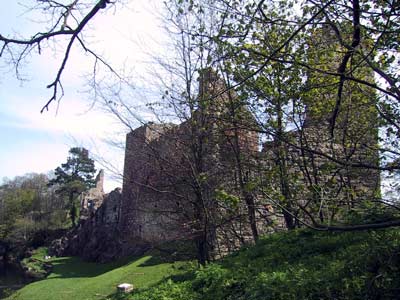 |
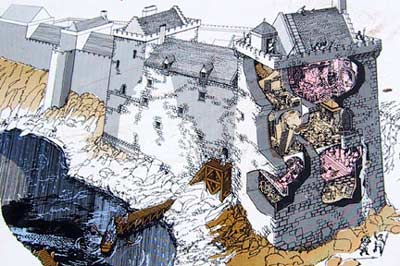 |
| Open all year. Tel.: 44+ (0)131 668 8800 Click here for more info about Hailes Castle. |
|